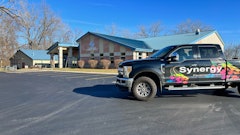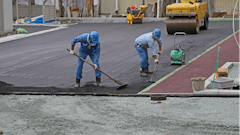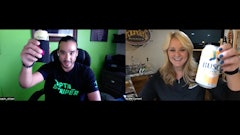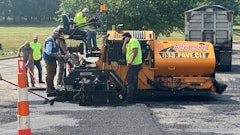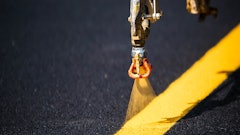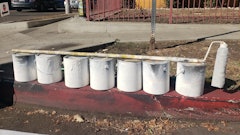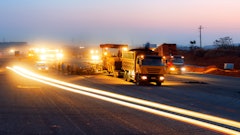
Corky Caprara says he “always had an affinity for racing.” He grew up in the hotbed of National Hot Rod Association racing in Southern California and in college sold seat cushions at Ontario Motor Speedway. Once seat cushions were sold out he wandered the track with an all-access pass.
“Back in the day you could get up close to the racers. I’d literally be right next to the cars as they were working on them and used to shake hands with A.J. Foyt and Mario Andretti and others and it was no big deal. I had unlimited access to them,” Caprara says.
Today his company, United Striping 101, Petaluma, CA, handles all the pavement marking duties for Sonoma Raceway – and has handled those duties for 27 years, the longest-serving independent contractor at the track.
“Working at Sonoma Raceway is the high point of my year for striping,” Caprara says. “I love being at the track.”
A Road Course for NASCAR
Originally built in 1968 as Sears Point Raceway, Sonoma Raceway is one of two road courses (as opposed to a racing oval) on the NASCAR circuit. It features more than 160 ft. of elevation change from its highest point (Turn 3a, 174 ft.) to its lowest point (Turn 10, 14 ft). Drivers who complete the 110 laps in the Toyota/Save Mart 350 NASCAR Sprint Cup race, held each June, will make 1,100 turns around the road course. In addition to the track, the raceway houses a motorsports industrial park of more than 70 businesses in 104 shops.
NASCAR began running a race at Sonoma Raceway in 1989, and United Striping 101 did its first job for them in 1990. “The relationship slowly developed from that and now we provide service year-round,” he says. I’m in my 27th year of striping the track and I’m the longest-running independent contractor at the raceway.” From the end of March to the end of September United Striping 101 is at the track several times a month doing normal striping including restriping the parking lot, property entrances and exits, updating ADA striping, lining out spaces on a 50-acre RV parking lot and restriping the ring road around the track.
Sonoma Raceway hosts as many as five major racing events each year (NASCAR, AFM Motorcycles, National Hot Rod Association, Indy Cars and Vintage Car Road Races, among others). Each racing series develops a plan for their event, and United Striping 101 executes that plan including restriping and alterations.
“We have a general way we proceed and attack the work, and that’s how we plan it out and execute it. But we’re very fluid and very flexible for them and that’s probably one of the reasons we’ve been with them for 27 years,” he says.
The Start of United Striping 101
With his wife, Marsha, and his brother Joe, Caprara started United Striping 101 in 1985, after he’d worked several years for a small striping contractor where he learned the business “on the fly.”
“We started and flourished in what was a good economy at the time,” he says. “It was a good time to start.”
Caprara says that while he started out only striping parking lots, it wasn’t long before he added other services. “I was young and foolish so we weren’t afraid to try things. We added pavement marker installation, then thermoplastic, steel bollard installation and even survey monuments (the brass pins set to exact marks for surveyors). Anything that our customers wanted that was within reason and that we thought we could make a few bucks off we would attempt.”
United Striping 101 grew to 10 employees, and when his brother left the company, Caprara decided to scale down the business because “with that many employees I found it was kind of like babysitting.”
Today United Striping 101 has four full-time employees that bumps up to nine in peak season. Several years ago they added sealcoating to the business after dabbling in it for 15 years, investing in an 800-gal. application tank. Most of the company’s work is as a subcontractor and is done on commercial properties, with 30% of revenue generated by sealcoating and 70% by striping and “other.”
Staging on Monday
For NASCAR’s Toyota/Save Mart 350 in June, for example, NASCAR takes control of the track one week out. Friday and Saturday are practice and time trials and Sunday is the race. But United Striping 101 starts its work three weeks prior to the race, striping and painting the property. Starting on the Monday before the race all focus is on the track.
On the Monday prior to Sunday’s NASCAR Toyota/Save Mart 350 race, United Striping 101 arrives on site early, setting up for what will 16-hour-long days until the race starts Sunday morning. United Striping heads to Turn 11, which it sets up as a staging area. Paint is delivered from the supplier; striping, sealcoating, track cleaning and support equipment is brought to the site, and a canopy is set up to provide shade. “We’ll be living there for a week, eating breakfast, lunch and dinner so we set it up to accommodate our team,” he says.
United Striping uses as many as eight walk-behind stripers because of the number of different colors and because they don’t want to swap out oil-based machines for water-based paint and vice versa. He says that for the NASCAR event alone United Striping 101 uses up to 900 gals. of paint for one week of racing. Most-used colors are blue, yellow and white but black, red and green also are used as are custom colors (for the logos). Some paint is water-based depending on where it’s used; paint on wear surfaces, berms and edges is oil-based.
“It’s a big paint order but our supplier knows it’s coming and it comes around the same time every year so they’re ready for it. We order it at the beginning of May so we’re sure to have what we need, then tweak the paint order as we learn more about what logos there will be and what NASCAR might need,” he says.
Caprara uses three or four crews working simultaneously throughout the track all week, working up to 95 hours from Monday through Sunday morning. “We’re out there starting on Monday and we have to have the track completely painted by the end of the day Thursday because Friday and Saturday they have practice and qualifying runs, which are televised so the track needs to look its best,” he says.
Logos at the Track
Once United Striping 101 is staged, crews start working on the aerial logos which are placed in runoff areas, runoff turns, chutes and hairpin turns. Caprara says there are as many as 11 different logos at a typical NASCAR race. Logos range in size from 8 ft. x 10 ft. to as large as 60 ft. x 120 ft. and United Striping applies them from custom-made stencils.
At some races logos are painted on grass, but because Sonoma gets so little rain during the summer logos don’t look good on dried out grass so all logos are placed on asphalt so they show up better from the air. To make logos look even better United Striping often sealcoats the area a logo will be placed. “Sealcoating beneath logos gives us a fresh black surface to paint on, so in some instances we’ll sealcoat an area first,” he says.
Then the first coat for logos is applied with water-based paint because Caprara says water-based paint doesn’t damage the asphalt as much as oil-based can.
“All through the days we work on the logos through Thursday because we have to allow them to dry before adding other colors,” he says. “There’s a lot of fine tuning on the logos on Thursday. Plenty of detail that takes a while because we want them perfect.
“We’re actually down on our hands and knees with a paint brush to get edges perfect,” he says. “People actually walk on top of the logos that’s why we fine tune them. We’ll literally be on hands and knees to make it as perfect as we can so when people look down they see a perfect logo. You couldn’t see any of the rough edges on TV but people right on top of it looking down can so we want it perfect.”
Striping the Track
On Tuesday and Wednesday crews continue work on logos and also stripe in the pits, using stencils for any numbers on the pavement or on pit walls to aid the drivers coming into the pits. Wednesday continues grounds striping, logos and finishing pit work
On Thursday crews finally hit the track, taking a full day to stripe a 5-in. yellow line on both edges of the track. Crews used walk-behind units to stripe the almost four miles. Then they tackle the yellow-and-blue Cal-Canes (red-and-white Candy Canes on other tracks) berms throughout the track’s 11 turns. They’re yellow-and-blue at the suggestion of Steve Page, track president and CEO who attended UC Berkeley. Cal-Canes are first wet and blown clean with a high-powered track blower so the paint sticks. Then because they are of different sizes ranging from 3 ft. x 3 ft. to 3 ft. x 6 ft., Cal-Canes are painted freehand using a small spray striper off the back of a truck.
The same day they stripe the edges and the Cal-Canes, United Striping 101 uses templates to paint the elaborate black-and-white checkered start/finish line, with “Sonoma” on either side of the squares.
Work on the track is usually completed by 8:00 p.m. on Thursday, and drivers practice all day Friday until about 7:00 p.m. And then United Striping crews are ready to go again.
“Once the track goes cold we’re out there all Friday night and Saturday night after time trials painting damage done during the day,” he says. “We restripe and get it back to looking brand new for the next day. It can be a pretty involved process.”
“We make sure we like everything on the ground because if we don’t like it on the ground we know we’re not going to like it from the air on TV,” Caprara says. “How many people can claim their work is going to be watched on TV by millions of people?”












